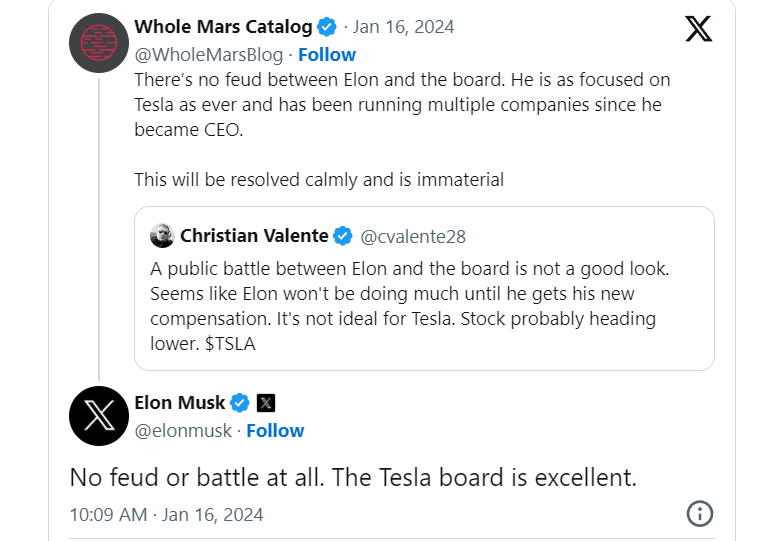Tesla executives are also at loggerheads.?Musk wants at least 25% voting control of company
On January 16, Musk said on his social platform X that he would be reluctant to make Tesla a leader in artificial intelligence and robotics if he did not gain at least 25% of the company's voting control.。
Following OpenAI, Tesla's interior also faintly reveals an atmosphere of "palace fighting."。
On January 16, Tesla CEO Elon Musk said on his social platform X that he would be reluctant to make Tesla a leader in artificial intelligence and robotics if he did not gain at least 25% of the company's voting control.。

Musk is not shy about expressing his desire to control Tesla.。He wrote on X: "If I have a 25% stake, it means I have influence, but if twice as many shareholders vote against me than support me, I can be overturned.。"
Musk currently owns more than 12% of Tesla, and he wants twice as much voting control as he does now.。Musk believes that if his decision can be easily overturned, he will build artificial intelligence or robotics products outside of Tesla.。
Musk says he is willing to adopt Dual Class Voting Structure to achieve his goal of 25% voting control。
In general, companies with a two-tier shareholding structure own two or more stocks with different voting rights, and in reality the two voting rights are more common。Founders or early investors usually have a larger voting power, while other shareholders have fewer。
For example, in the case of electric vehicle manufacturer Weilai, the shares held by Chairman and CEO Li Bin are Class C common shares, as opposed to Class A common shares held by ordinary shareholders.。One share of Class C common stock corresponds to eight votes in the Board of Directors of NIO。Therefore, even if Li Bin is not the company's largest shareholder, he only holds 10.5% shares, but its counterpart is 44.2% of the voting rights, still the actual controller of Weilai。
But Musk's idea is beautiful, but the reality is very "bone feeling"。Because Tesla has completed its IPO, it has been unable to change the company's shareholding structure.。Musk said, "I have no problem with the two-tier voting structure, but I have been told that (Tesla) is impossible after the Delaware IPO."。"
Musk is so keen to "control" Tesla that the outside world can not help but wonder whether there is a conflict with the company's board of directors。
In response to a post questioning the "fight" between Musk and the board, Musk wrote that he had "no grudges and no fights" with the board and praised Tesla's board as "excellent."。

Musk also said that Tesla's board did not have a new "compensation package" because it was hindered by an undecided case.。
Back in 2018, Tesla shareholder Richard Tornetta sued Musk and Tesla's board of directors.。Tonetta believes Musk has used his dominance on Tesla's board to earn a huge salary without having to work at Tesla。Currently, the lawsuit is not yet closed。
While Musk has denied fighting with the board or shareholders, there has been a lot of skepticism from shareholders about Musk.。For example, Musk doesn't have any Tesla high-level succession plans, or Musk as Tesla's CEO, but doesn't devote himself to Tesla.。After Musk acquired social media platform X in 2022, he put a lot of thought into X, not to mention that he has other companies like SpaceX.。
Musk's thirst for control of Tesla is also related to his views on the risks of artificial intelligence。On more than one occasion, Musk has publicly expressed his concerns about the development of artificial intelligence.。He had predicted that super-intelligence - artificial intelligence that is smarter than humans - would arrive within five or six years.。
Unlike traditional car companies, Tesla has not only electric vehicles, but also involved in autonomous driving, supercomputers, robots and other fields, each of which is closely related to AI。Perhaps in Musk's view, only by taking control of Tesla in his own hands can we try to avoid Tesla's "going astray" in artificial intelligence.。
·Original
Disclaimer: The views in this article are from the original Creator and do not represent the views or position of Hawk Insight. The content of the article is for reference, communication and learning only, and does not constitute investment advice. If it involves copyright issues, please contact us for deletion.